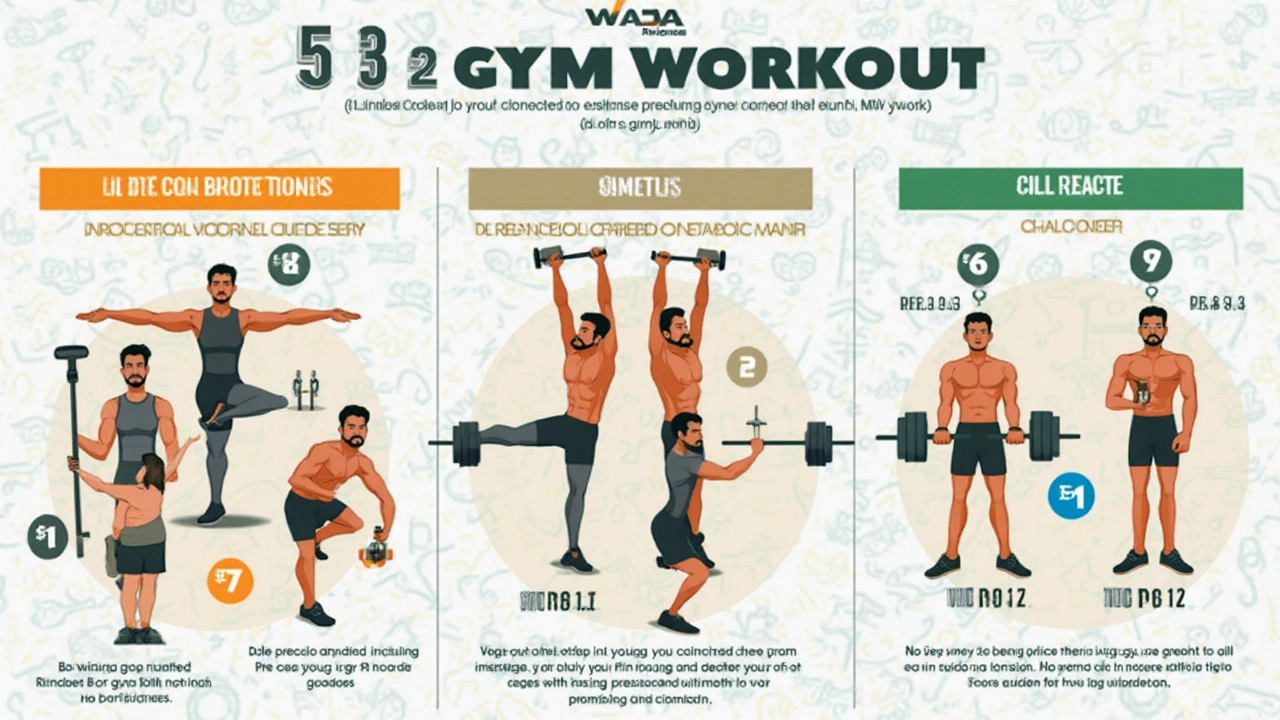5 3 2 Routine: How to Transform Your Body with This Simple Gym Workout Plan
 Jun, 27 2025
Jun, 27 2025
Ever notice how the simplest numbers can spark the biggest changes in your life? Here’s one that countless gym regulars keep in their back pockets: 5 3 2. Sounds cryptic, right? This little trio is the magic code behind a workout routine that’s been quietly fueling muscle growth in serious lifters for decades. No fancy tech, no exhausting hours—just an easy-to-remember formula that dials in perfect reps to boost both strength and confidence. It’s not a TikTok fad; it dates back to the fundamentals of classic powerlifting. But what actually happens during a 5 3 2 session, and why do some of the strongest people at your gym swear by it? Let’s break it down.
Unlocking the 5 3 2 Routine: Where Did It Come From?
Before everyone got obsessed with high-intensity cardio, the 5 3 2 routine was quietly moving iron in old-school gyms across the country. Powerlifters looking for steady strength gains leaned into low-rep, high-weight patterns to push their limits, and the 5 3 2 routine was one of their favorites. The idea is simple: for each major lift—think squat, bench press, deadlift—you perform three distinct "work sets" using increasing weight and decreasing reps: first set of 5 reps, then 3, then finally, just 2. What’s wild is how this structure mimics your body’s natural adaptation curve. Your muscles get enough volume to stimulate growth, but the later "heavy" sets challenge neuromuscular strength without frying your system. The routine’s been referenced in strength circles for years—Mark Rippetoe’s "Starting Strength" nods at similar patterns, though 5 3 2 itself really rooted in powerlifting clubs where trainees wanted a reliable way to add weight to the bar without wrecking recovery.
A fun fact? The structure actually matches the progression toward a personal record (PR) attempt. Pretend you’ve got a heavy deadlift goal: you start lighter to wake up your muscles (those 5 reps), then go heavier for 3, and by the time you're trying the 2-rep set, your body’s primed for peak performance. Science backs this up. Studies on strength development show that sets of lower reps with heavier weights help develop maximal strength efficiently—plus, they’re less likely to burn you out compared to marathon lifting sessions. That’s why you’ll see elite lifters capping the day with a heavy double or single.
What’s changed since the early days? Nothing much, honestly. The 5 3 2 routine is still going strong in 2025, because it just works. It strikes a smart balance: enough weight to trigger growth, but not so much you crawl home after. And unlike more advanced periodization plans with fancy spreadsheets, you don’t need a calculator to figure it out. Just the willingness to get under the bar and focus on quality reps.
How the 5 3 2 Routine Works: Breaking Down the Format
This is where things get refreshingly simple. A 5 3 2 session usually starts with a solid warm-up, getting your joints and muscles ready for the big lifts. Don’t skimp on this—think foam rolling, dynamic stretches, and a few lighter sets. Then, you move to the main event:
- First set: 5 reps with a moderately heavy weight—about 75-80% of your estimated one-repetition maximum (1RM).
- Second set: 3 reps with a challenging but manageable weight—roughly 85-90% of your 1RM.
- Third set: 2 reps with your heaviest weight of the day, shooting for 90-95% of your 1RM.
The numbers work like a pyramid; they start broader and get sharper. While this isn’t a high-volume routine (compared to, say, German Volume Training), it’s dialed in for pure strength. By the time you hit that last set of two reps, you want the bar to feel heavy—but not so much you lose form or confidence. The secret sauce here is that each set preps your nervous system for the next, and the whole sequence is over before fatigue catches up to your technique.
For most people, the 5 3 2 setup slots easily into a 3- or 4-day split routine. You might tackle squats on Monday, bench on Wednesday, and deadlift on Friday. Since the workload isn’t enormous, you could pair your 5 3 2 lift with accessory work—things like pull-ups, dips, or rows—to round out the session. Another bonus? Fewer reps means less time in the gym, which is huge if you’re juggling work, family, or Netflix.
This routine is easy to progress with: add 2.5 to 5 pounds to your lifts every couple of weeks. If you crush every set with good form, bump the weight up next time. But if you start failing reps or your form gets sketchy, hold steady or drop back a notch.

Why Lifters Love the 5 3 2 Routine: Strength, Simplicity, and Steady Gains
So what makes the 5 3 2 routine stick out among the ocean of other gym plans? Lifters love it because there’s almost zero confusion—just focus on those three sets and push. Simplicity is power. You aren’t bogged down by endless circuits or weird rep schemes. Plus, because the work sets are so focused, you can really dial in technique and mental toughness. That’s huge for making your lifts cleaner and safer.
Another reason? No matter how busy (or lazy) your week gets, the routine is short enough that you can’t make excuses. It fits a 45-minute window, including your warm-up. Consistency beats intensity, every time. When you actually look forward to your session, because you aren’t dreading hours of squats, you’ll go more often. More days in the gym just equals more gains—plain math.
There’s also a built-in boost to your confidence. Since you’re lifting heavier weights in low reps, you get comfortable moving big numbers. This can carry over to other areas of your life, too. Who doesn’t want to leave the gym feeling like a superhero?
If you check lifter forums or talk to coaches, you’ll hear story after story about strength plateaus shattered with the 5 3 2 routine. The structure is adaptable: beginners can use lighter starting weights and master good form, while advanced lifters love it as a way to ramp up to one-rep maxes or break PR droughts.
Getting the Most from the 5 3 2 Routine: Tips and Best Practices
The first tip: pick your lifts wisely. This routine shines with barbell basics—squat, deadlift, and bench press. Trying to apply 5 3 2 to curls or triceps kickbacks? Kind of missing the point. Stick to the big compound movements that use lots of muscle groups and actually benefit from heavier weights.
Next, keep rest periods honest. You’re working near your max, so two to four minutes between sets is fine. Rushing just tanks your performance. And don’t skip your warm-up, ever. It’s not just about being safe, but priming your body to actually make the lift.
Recovery is everything. These sessions can feel deceptively short, but you’re moving serious weight. Sleep as much as you can manage and keep an eye on your nutrition—especially protein. Most people see the best results running the 5 3 2 routine just twice a week per lift. Any more, and you risk stalling or burning out. Listen to your body’s feedback. If your joints ache or your numbers start slipping, back off or swap in some lighter weeks.
Finally, log your workouts. The best way to make progress is by tracking each set and weight, so you know when it’s time to bump things up. There are plenty of free apps if you hate notebooks. And remember, progress doesn’t always mean adding weight. Better technique or easier reps count just as much. If you can master clean reps with heavier weight, you’re winning.

Troubleshooting and Common Mistakes in the 5 3 2 Routine
Okay, now for the reality check. The 5 3 2 routine works, but it isn’t magic. The first mistake people make: picking weights that are too heavy right off the bat. The goal is steady, sustainable gains. If you fail reps early, you’re either doing too much or moving too fast. Take your ego out of it. Build slowly, and you’ll avoid injuries or crushing setbacks.
Another pitfall? Bad form. Low reps and heavy weights tempt lifters to cheat or get sloppy. Always prioritize technique, even if it means lowering the weight a bit. Record your sets, or ask a friend to watch your form occasionally. Feedback is priceless.
Some folks get bored and rush to add flashy variations—don’t. Save bands, chains, and exotic exercises for later. The 5 3 2 routine is a classic for a reason: it thrives on repetition and focus. However, it’s smart to swap between lifts if you hit a plateau. For instance, alternate between back squats and front squats every cycle, or use sumo deadlifts for variety.
A final tip: Don’t ignore accessory work. The main lifts are the *meat* of the routine, but adding in rows, chin-ups, or core exercises helps support overall strength and avoid imbalances. Just keep the accessory stuff light and not too complicated. You want to be fresh for those main heavy sets, not exhausted before you even start.
And remember, there’s no universal best routine—but the 5 3 2 routine is a time-tested starting point for lifters who want big results from a smart, time-efficient plan. No fragile spreadsheets, no endless reps in the slog of cardio. Just you, the bar, and some numbers that add up to real progress. The only thing left is putting in the work—and maybe snapping a quick gym selfie when you hit that next PR.
